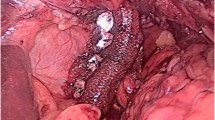Abstract
Introduction
The treatment of hernias remains controversial, with multiple prosthetic meshes being exalted for a variety of their characteristics. In the event of incarcerated/strangulated hernias and other potentially contaminated fields the placement of prosthetic material remains controversial because of increased risk of recurrence and infection. Porcine small intestinal submucosa mesh (Surgisis, Cook Bloomington, IN) has been demonstrated safe and feasible in laparoscopic hernia repairs in this scenario. We present our 5-year experience, with placement of Surgisis mesh in potentially or grossly contaminated fields.
Methods
From May 2000 to October 2006, 116 patients (52 male, 64 female) with 133 procedures were performed. Placement of Surgisis mesh for either incisional, umbilical, inguinal, femoral or parastomal hernia repairs in an infected or potentially contaminated setting were achieved, and studied in a prospective fashion.
Results
All procedures were laparoscopically with two techniques [intraperitoneal onlay mesh (IPOM) and two-layered “sandwich” repair]. Mean follow-up was 52 ± 20.9 months. Thirty-nine cases were in an infected field and the rest in a potentially contaminated field. Ninety-one procedures were performed concurrently with a contaminated procedure. Twenty-five presented as intestinal obstruction, 16 strangulated hernias, and 17 required small bowel resection; 29 were inguinal hernias, 57 incisional, and 38 umbilical. In 13 patients more than two different hernias were repaired. Eighty-five percent 5-year follow-up was achieved, during which we identified 7 recurrences, 11 seromas (all resolved), and 10 patients reporting mild pain. Six second looks were performed and in all cases except one the mesh was found to be totally integrated into the tissue with strong scar tissue corroborated macro- and microscopically.
Conclusions
In our experience the use of small intestine submucosa mesh in contaminated or potentially contaminated fields is a safe and feasible alternative to hernia repair with minimal recurrence rate and satisfactory results in long-term follow-up.



Similar content being viewed by others
References
Badylak SF, Coffey AC, Lantz GC, Tacker WA, Geddes LA (1994) Comparison of the resistance to infection of intestinal submucosa arterial autografts versus polytetrafluoroethylene arterial prostheses in a dog model. J Vasc Surg 19(3):465–472
Franklin ME Jr, Gonzalez JJ Jr, Michaelson RP, Glass JL, Chock DA (2002) Preliminary experience with a new bioactive prosthetic material for repair of hernias in infected fields. Hernia 6(4):171–174
Franklin ME Jr, Gonzalez JJ, Glass JL (2004) Use of porcine small intestine submucosa as a prosthetic device for laparoscopic repair of hernias in contaminated fields: 2-year follow-up. Hernia 8(3):186–189
Clarke KM, Lantz GC, Salisbury SK, Badylak SF, Hiles MC, Voytik SL (1996) Intestine submucosa and polypropylene mesh for abdominal wall repair in dogs. J Surg Res 60(1):107–114
Ueno T, Pickett LC, de la Fuente SG, Lawson DC, Pappas TN (2004) Clinical application of porcine small intestinal submucosa in the management of infected or potentially contaminated abdominal defects. J Gastrointest Surg 8:109–112
Catena F, Ansaloni L, Leone A, De Cataldis A, Gagliardi S, Gazzotti F, Peruzzi S, Agrusti S, D’Alessandro L, Taffurelli M (2005) Lichtenstein repair of inguinal hernia with Surgisis inguinal hernia matrix soft-tissue graft in immunodepressed patients. Hernia 9(1):29–31
Smith MJ, Paran TS, Quinn F, Corbally MT (2004) The SIS extracellular matrix scaffold-preliminary results of use in congenital diaphragmatic hernia (CDH) repair. Pediatr Surg Int 20(11–12):859–862. Epub 2004 Nov 24
Ansaloni L, Catena F, D’Alessandro L (2003) Prospective randomized, double-blind, controlled trial comparing Lichtenstein’s repair of inguinal hernia with polypropylene mesh versus Surgisis gold soft tissue graft: preliminary results. Acta Biomed Ateneo Permense 74(Suppl 2):10–14
Helton WS, Fisichella PM, Berger R, Horgan S, Espat NJ, Abcarian H (2005) Short-term outcomens with small intestinal submucosa for ventral abdominal hernia. Arch Surg 140(6):549–560
Silverman RP, Singh NK, Li EN, Disa JJ, Girotto JA, Slezak S, Goldberg NH (2004) Restoring abdominal wall integrity in contaminated tissue-deficient wounds using autologous fascia grafts. Plast Reconstr Surg 113(2):673–675
Szczerba SR, Dumanian GA (2003) Definitive surgical treatment of infected or exposed ventral hernia mesh. Ann Surg 237(3):437–441
Schmitt HJ Jr, Grinnan GL (1967) Use of Marlex mesh in infected abdominal war wound. Am J Surg 113(6):825–828
Jones JW, Jurkovich GJ (1989) Polypropylene mesh closure of infected abdominal wounds. Am Surg 55(1):73–76
Author information
Authors and Affiliations
Corresponding author
Rights and permissions
About this article
Cite this article
Franklin, M.E., Treviño, J.M., Portillo, G. et al. The use of porcine small intestinal submucosa as a prosthetic material for laparoscopic hernia repair in infected and potentially contaminated fields: long-term follow-up. Surg Endosc 22, 1941–1946 (2008). https://doi.org/10.1007/s00464-008-0005-y
Received:
Revised:
Accepted:
Published:
Issue Date:
DOI: https://doi.org/10.1007/s00464-008-0005-y



